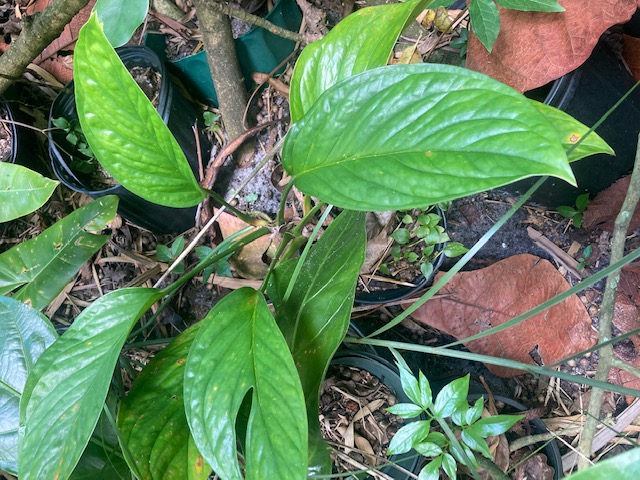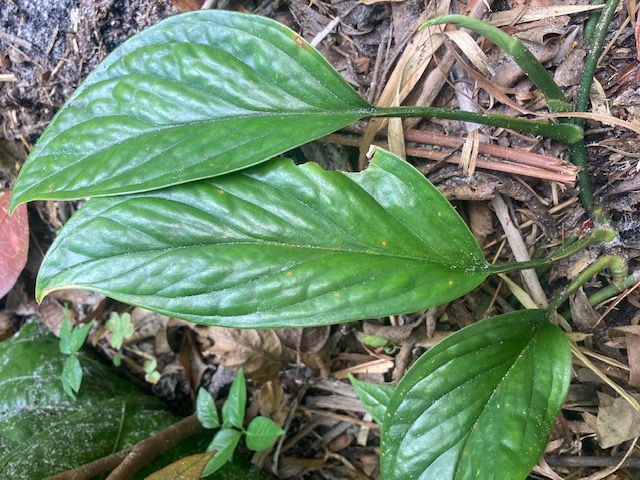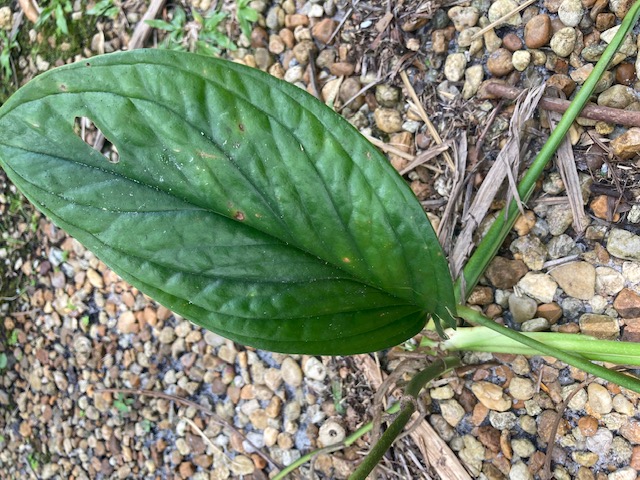Dear Chris: It must have been Mike Grayum
Grayum, M. H. 1997. Nomenclatural and taxonomic notes on Costa Rican Araceae. Phytologia 82(1):
49. Madison’s 1977 Revision of Monstera still included it as the illegitimate Monstera dilacerate. The type of that species turned out to be an Epipremnum from SE Asia.
Tom .
From: Aroid-L <aroid-l-bounces@gizmoworks.com>
On Behalf Of D. Christopher Rogers
Sent: Tuesday, May 3, 2022 6:25 AM
To: Discussion of aroids <aroid-l@gizmoworks.com>
Subject: Re: [Aroid-l] Juvenile pictures of monstera
When and who resurrected M. pinnatipartita?
On Mon, 2 May 2022 at 20:31, Tom Croat <T*@mobot.org> wrote:
Dear All: I can’t be certain without locality data but the juvenile leave shown hear certainly resemble those from a plant on Barro
Colorado Island that I initially called Monstera dilacerate and which later became M. pinnatipartita.
Tom
From: Aroid-L <aroid-l-bounces@gizmoworks.com>
On Behalf Of D. Christopher Rogers
Sent: Monday, May 2, 2022 8:28 AM
To: Discussion of aroids <aroid-l@gizmoworks.com>
Subject: Re: [Aroid-l] Juvenile pictures of monstera
Steve Marak and I discussed the taxonomy of Monstera karstenianum at length some time ago. I am not sure we finally figured it all out,
but here is what I found from the literature (if I am very much wrong, I hope maybe Tom or Peter or Joep or someone else can straighten me out):
Schott (who originally described and defined the genus Philodendron) treated all members of what we today call Philodendron subgenus Pteromischum
as Monstera. Schott (1856) described described Monstera karstenianum. At some point, it was moved with the other Schott Pteromischum species into Philodendron by Engler.
Grayum (1996) revised subgenus Pteromischum, and states that Schott's types of karstenianum actually
are a mix of several species. Grayum goes into great detail on P. karstenianum, and why the specific identity is ambiguous, and why the name is currently rejected. So, the correct name for what was originally
being called M. karstenianum is probably P. opacum. According to the IPNI and The Plant List, the proper name is now Philodendron opacum Croat & Grayum, 1992.
But obviously, Don's plant is absolutely a Monstera and not a Philodendron. So what is it? There is an old name of Monstera peruvianum
still bouncing around, and I agree with Malwi that Don's plant seems similar to what was described as M. pinnatipartita. So what happened to those names?
Madison in his revision of Monstera (1977) treats both M. pinnatipartita and M. peruvianum as synonyms of M dilacerata. The distribution
is Guatemala to Peru.
"The Peruvian material of this species generally has only 4-6 pinnae per side, whereas Central American Monstera dilacerata has 7-12 pinnae; this
has been the basis for the separation of M. peruviana. However, material from the two areas agree in all other respects and as the extremes of pinna condition are connected by many intermediates there appears
to be little or no basis for maintaining M. peruviana as a separate taxon. The lengths of the peduncle and the spadix are quite variable in Monstera dilacerata, the former ranging from 12-27 cm. However, these characters are quite variable, even within
an individual plant, and appear to have no taxonomic significance."
I suspect that what we have here is the same situation as "Pothos" and Epiprenum aureum: the name Monstera karstenianum 'Peru' may be just
a horticultural name for M. dilacerata from the Peruvian end of the species spectrum of variability, and not really have any basis in science. If someone knows more; please share.
Regardless, Don: that is a spectacular plant!!
On Sun, 1 May 2022 at 17:50, Don Bittel <d*@hotmail.com> wrote:
Here are pictures of the juvenile form of the monstera that I think is ‘Peru’.
I bought it as an unidentified plant at the aroid show about 30 years ago. If it’s not ‘Peru’ and is actually pinnatipartita, how do you tell the difference?
This juvenile plant is definitely the plant that I sent the original pictures of. Do you have pictures of a true pinnatipartita?
Don Bittel

_______________________________________________
Aroid-L mailing list
Aroid-L@gizmoworks.com
https://gizmoworks.com/cgi-bin/mailman/listinfo/aroid-l
--
D. Christopher Rogers
((,///////////=======<
785.864.1714
Associate Research Professor
Kansas Biological Survey
The University of Kansas, Higuchi Hall
2101 Constant Avenue, Lawrence, KS 66047-3759 USA
Associate Editor, Journal of Crustacean Biology
Southwest Association of Freshwater Invertebrate Taxonomists
_______________________________________________
Aroid-L mailing list
Aroid-L@gizmoworks.com
https://gizmoworks.com/cgi-bin/mailman/listinfo/aroid-l
--
D. Christopher Rogers
((,///////////=======<
785.864.1714
Associate Research Professor
Kansas Biological Survey
The University of Kansas, Higuchi Hall
2101 Constant Avenue, Lawrence, KS 66047-3759 USA
Associate Editor, Journal of Crustacean Biology
Southwest Association of Freshwater Invertebrate Taxonomists
|




